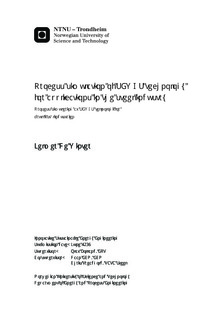Process simulation of SEWGS technology for applications in the steel industry: Prosess simulering av SEWGS teknologi for bruk i stålindustrien
Master thesis
Permanent lenke
http://hdl.handle.net/11250/235653Utgivelsesdato
2014Metadata
Vis full innførselSamlinger
Sammendrag
As part of the Dutch national program on CO2 capture (CATO-2), in particular ECN s research within the CEASAR project, this study primarily focuses on capturing CO2 from point sources in the steel industry. Central in this study is the Sorption Enhanced Water-Gas Shift (SEWGS) technology for decarbonizing the Blast Furnace Gas product stream from the iron and steel making process. Detailed process simulation software (Aspen HYSYS) was used to model several combined power cycle layouts with SEWGS pre-combustion CO2 capture. Moreover, a techno economic evaluation of different SEWGS layouts and applications in alternative steel making cycles has been investigated as well.Three different SEWGS layouts have been compared to two reference scenarios, a no-capture combined cycle and a post-combustion capture case using amines. Subsequently, SEWGS layouts where simulated using multiple target variables: Minimum energy consumption, minimum SEWGS train configuration, SEWGS column reduction and variable Blast Furnace Gas (BFG) compositions. Simulation results showed significant efficiency penalties for the three SEWGS layouts operating with minimum energy consumption, ranging from 18 to 22 %-pnt at a 95% CO2 capture rate. Main reason are steam extractions for SEWGS operation and pre-shift steam consumption to prevent catalyst dryout. Second, lower gas turbine work is experienced in all SEWGS cycles due to the composition and volumetric flow rate of the fuel, which is lower for diluted hydrogen than for BFG. An alternative modeling layout using split flow principle for the pre-shift section was proposed and found to improve energy efficiency by about 3.7 %-pnt. On the other hand, significant cost improvement has been achieved by optimizing the sorbent productivity to bring down the number of SEWGS trains needed. Bringing down the number of trains to a 6x9 configuration reduced capital cost by about 30% at the expense of higher steam requirement, which improved heat integration options to minimize efficiency losses. Subsequently, detailed cycle modeling showed the possibility to omit SEWGS cycle steps to bring down the number of columns per train. Several options where simulated after which the 6x6 configuration, using just two pressure equalizations steps, appeared to be most cost effective (55 /tonneCO2). Besides, sensitivity study showed the blast furnace gas composition to have strong influence on the CO2 avoidance rates because of non-converting hydrocarbons and a pre-shift that is sensitive to CO concentrations.
